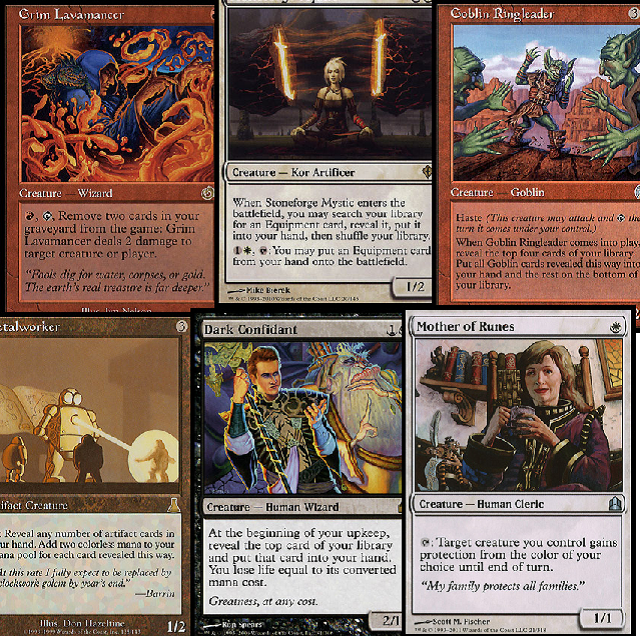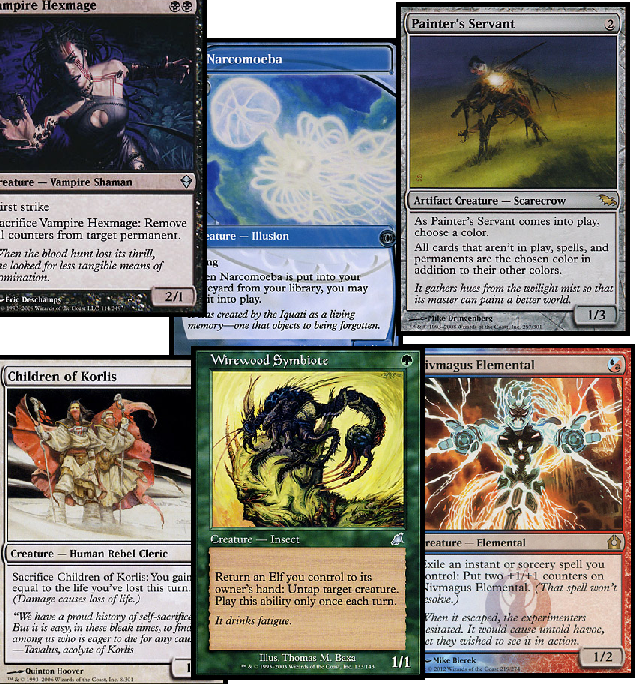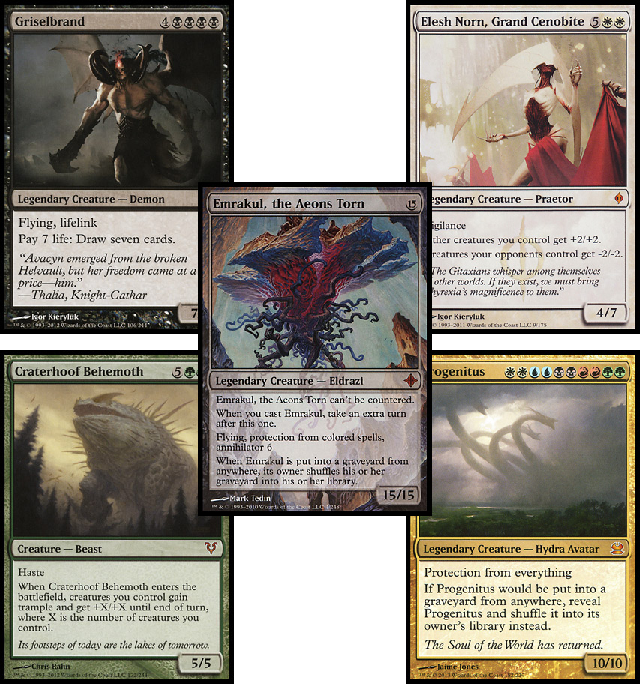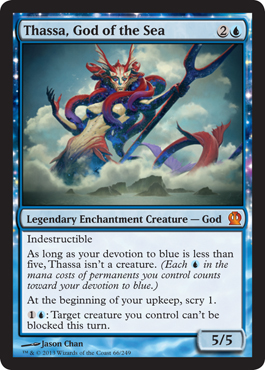I’m here today to talk about something that I don’t really like to talk about all that much: creatures! Specifically, what makes a creature considered “good enough” for Legacy. Those that know me well are probably scratching their heads, wondering, “Tim, why on Earth do you want to talk about creatures?? You HATE creatures!” It’s true, the only thing I usually like doing with creatures is getting rid of them. Whether I’m exiling them, destroying them, sending them to the bottom of the library, or just saying, “No,” and countering them, I love rendering creatures useless, and finding ways to win by playing as few of them as possible. Of course, I am not always successful in my mission of “Destroy all the monsters,” and have taken my share of beatings from those awful cards with power and toughness boxes, so I have a pretty good idea of what makes a creature good enough for Magic’s most diverse format.
The Five Creatures You Meet in Magic
Yeah, yeah, I just ripped off the title of Wen Fu’s recent mini-series of articles, who in turn, ripped of Mitch Albom’s title. Sorry to both of you that I have now sullied your good names by having you forever linked to a rapscallion like me in Google searches. Anyways, to evaluate whether or not a creature is Legacy-playable, it helps to break down the current format staples into broad categories, and in my analysis, I came up with five (plus a sixth “Other” category that really just exists to catch a few exceptions).
Rate
The first thing a creature needs to be considered Legacy-playable is an efficient rate. So what makes for an efficient rate? Below are some of the most efficient rates in the game, yet even still, not all of these are good enough for Legacy.
While a 3/3 for one mana seems like a fantastic rate, Wild Nacatl hasn’t seem serious Legacy play in quite some time. Okay, he’s technically not a 3/3 by default, but his condition for becoming a 3/3 is generally easier to turn on, right? You just need to get a Plateau. But therein lies the problem: if you’re operating Nacatl at maximum efficiency, that means you’re playing Naya, which likely means that your deck is bad. (So, this card that was banned in Modern isn’t good enough for Legacy? This is why Modern will NEVER be Legacy. Okay, end side tangent of me unprovokedly hating on Modern.) Meanwhile, Delver and one of the many sidekicks he’s often seen hanging out with, Nimble Mongoose, routinely crush tournaments, yet it seems that their respective conditions that needs to be met to ensure that you get three power for one mana seem far more difficult to meet than simply playing a Plateau, right? Not only do the color requirements make Nacatl see less success, but also the additional abilities. You need to be BETTER than JUST three power for one mana. You need some flying or shroud to go with that. If you want to compete on pure rate, you need to stack up against the granddaddy of efficient rates, Mr. Tarmogoyf. Kird Ape, which used to see play in the Zoo decks that featured Nacatl has also faded from the format, for the most part, and sees a light amount of Modern play. Goblin Guide, while sometimes guilty of feeding your opponent free cards, is acceptable, thanks to his hastiness. Even though Tombstalker has a large retail price in his upper right (or left, if you prefer the OG version) corner, you’re always getting him on sale for about two or three mana, so he is also an acceptable play in decks that capable of generating a lot of card velocity. I suppose most of the Merfolk/Sliver lords also fall into this bucket, because even though the ratio of their base stats to their converted mana cost isn’t very impressive, they are usually adding a lot of power to your board for a small cost. This isn’t meant to be a comprehensive list, but just something to give you an idea of what sort of rate we need our creatures to give us in this format (if we’re interested in them solely because of rate, rather than other factors), and what might appear to be good enough, but really is not.
High Power Level Ability
This one also seems fairly obvious, right? Your creatures have to do something absurdly well. I say “absurdly,” because in a format where there are thousands of creatures to choose from, if you’re not being played for your rate, you’re going to have to have some exceptionally powerful ability to be one of the chosen few that have what it takes to have the privilege of getting to stare down or protect Jace, the Mind Sculptor.

If you look at the above collage, you will notice that many of these creatures have the ability to generate a significant amount of actual or virtual card advantage. Some times it’s a repeatable abilty, while other times, it is a powerful, one-shot ability. Stoneforge Mystic doubles as a toolbox and a means of cheating in a 4/4 that most fair decks will lose to if they don’t have an answer. Goblin Ringleader gives a mono-red deck more raw card than most blue decks, as it often “draws” three to four cards for the Goblin player. Bob represents an extra card every turn stapled to an efficient body that isn’t afraid to get into the red zone once all the threats are cleared. Metalworker allows an artifact heavy deck to accelerate into powerful endgame cards as early as turn three. Mom and Lavamancer also both have repeatable effects that can be downright oppressive to certain strategies.
Weird, Unique Ability That Can Become Broken
Looking at the creatures above, none of them seem like anything particularly special. Sure, they all have abilities that we don’t normally see, but in a vacuum, none of those abilities seem powerful, or worth a card. However, in the right shell, the power level of these creatures can reach disgusting level (okay, fine, maybe not Niv Magus Elemental; in the right shell, its power level goes from jank to borderline playable). Servant, Hexmage, and Children all serve as parts of various two-card combos that gets you to your victory formation. Symbiote and Narcomoeba both enable degenerate engines and also provide some early value before your engine is in full swing. Speaking of Narcomoeba, we can probably also include EVERY creature played in (both, Manaless and LED) Dredge in this category. In fact, most creatures that fall into this category are pieces of some sort of combo that enable you to play the game in a way that it was not meant to be played.
Giant (Usually) Uncastable Monsters
There’s not really a whole lot of explanation needed with this one. Get one of these fatties into play, win the game. That simple, right? Oh wait, what’s that in the top right-hand corner? Is that a ridiculous mana cost that we could never hope to pay (unless we’re playing 12-post)? No worries, I’ll just cast my Show and Tell/Reanimate/Natural Order. GG.
A Little of This and a Little of That
We talked about rate and powerful abilities a little earlier, but the truth of the matter is that most creatures don’t fall entirely into one of the two categories. There aren’t many pure rate creatures, because there aren’t really a lot of ways to differentiate them; most creatures aren’t going to have a rate better than Tarmogoyf, and the other popular rate creatures either have some sort of evasion (Delver), are harder to kill (Mongoose), or are in non-green decks (Goblin Guide). Similarly, as much as we love strong abilities on our creatures, we would like them to be cheap due to how early the fundamental turn is in Legacy, and it would be nice if they could get their hands dirty in the combat step once in awhile. Even the great Bob, who we earlier lumped into the Powerful Ability category, is actually more a hybrid, as he would be far less exciting if we shaved a point of power off his stats.
Some of the creatures in the collage above have a very strong ability. Others have a cocktail of abilities that, on their own, would be considered little more than “French Vanilla,” but working in concert on a single piece of cardboard, they give you a swiss army knife of value. All of them cost three or less mana, though I wouldn’t completely rule out four-drops; Venser, with his flashiness, his powerful and unique enters the battlefield trigger, and relevant body falls firmly into this bucket. Strix is loaded with keywords (and replaces itself!), while Deathrite is loaded with activated abilities. Clique flies, brings the beats, and strips them of their best card or helps you dig. Pridemage answers troublesome permanents while also providing three power for only two mana. If we ran an analysis on all of the creatures in the top eight of each Open in the last year, I would wager that this category easily comprises most of the creatures played in the format.
Other
There was bound to be an “Other” category with how diverse Legacy is, as I wasn’t expecting to be able to pidgeonhole EVERY creature played in the format into five general categories. You sometimes see a deck that just presents a pile of strange cards that look terrible, or at least below Legacy standards, on paper, but when they all come together, they’re full of all these crazy synergies that provide incremental advantage and end up crushing you. Most of the creatures in tribal decks like Elves and Goblins can be grouped into this category.
Right, So Where Are We Going With This??
Now that we know what it takes for a creature to get played in this format, I want to shift our attention to a new creature to consider. One that even I’m excited to play!
I usually try to wait until the full set is spoiled before I start talking about new cards, but for a guy like me, this one just hits all the right notes, and I feel like I have to say SOMETHING about the new dihydrogen monoxide (that’s just a fancy way of saying water, for all you non-chemisters) deity. I think she’s gooooood. Like reeeeeally good. Now, we all know this is a mostly Legacy-centric column, and here I am gushing over this card. I guess we should get right to it and address the elephant in the room: will Gods play a role in Legacy? I don’t know about plural (for now, anyways; rumor has it that each color pair will get a God in the next two sets, so maybe we get another hit), but I feel good about Thassa’s odds of making it to the big leagues. Also, just so we’re clear, when I talk about “big leagues,” I mean Legacy. Magic’s minor league system goes like this: Modern = AAA, Standard = AA, Limited = A. And Vintage is the Old Timers’ Game. What were we talking about again? Baseball? Gods? Can the Gods fix Matt Harvey’s arm? Nevermind, I digressed. They can’t fix a tear of the UCL, but Thassa CAN fix the top of your library!
Thassa seems like she could slot quite nicely into the 75 of Miracles as a one or two-of. Here’s what she has going for her:
- Clocking in at three mana, she is the least costly of the Gods. A (conditional) 5/5 for three mana! Remember, rate matters.
- Three is a good number to flip to Counterbalance for countering some of the more annoying cards that Miracles has to deal with. And by “more annoying cards,” I mostly mean Liliana of the Veil. I kind of hate her.
- You’re in a topdeck war, and feel like you have the edge, because you have a top, but all you keep seeing is chaff, with not a fetchland to be found. Thassa does a fine job of digging you out of this mess.
- An unblockable 5/5 indestructible creature is a decent way to quickly mop things up once you have everything under control and you’re just looking for a wincon.
- Thassa lies dormant, for the early game, dodging things like Terminus and Swords to Plowshares. Once she becomes a creature, it’s fairly likely that you can protect her.
- She isn’t all that hard to turn-on. No, not like that, you perverts! But if tentacles and gills are what you’re into… but seriously, you just need two out of the four of Jace, Counterbalance, Venser, and Clique.
- She is immune to Abrupt Decay! (Another card that I loathe.) If you’ve used Jace and Venser to hit the devotion quota, they can’t even Decay one of your other permanents to turn her back into a creature.
- She makes your Brainstorms better. Now you don’t need to have a fetch to ship the chaff.
- She gives you an additional means of pressuring Planeswalkers. She also can one-shot Jace even if he upticked.
I also think she will be a decent enabler to finally make Miracles “a thing” in AAA (along with all of the other scry cards that we’ll be getting). If we get enough reasonable instant speed scry, like the unsummon, I might even try my hand at Modern CounterTopScry. By next week, we should have the full set spoiled, and I’ll give you my full Eternal Review of Theros. There’s a few other cards that I have tabbed for “potential,” but Thassa aside, I’m holding my tongue until we get the full spoiler. Until then, may the Gods smile upon you, or something like that.






